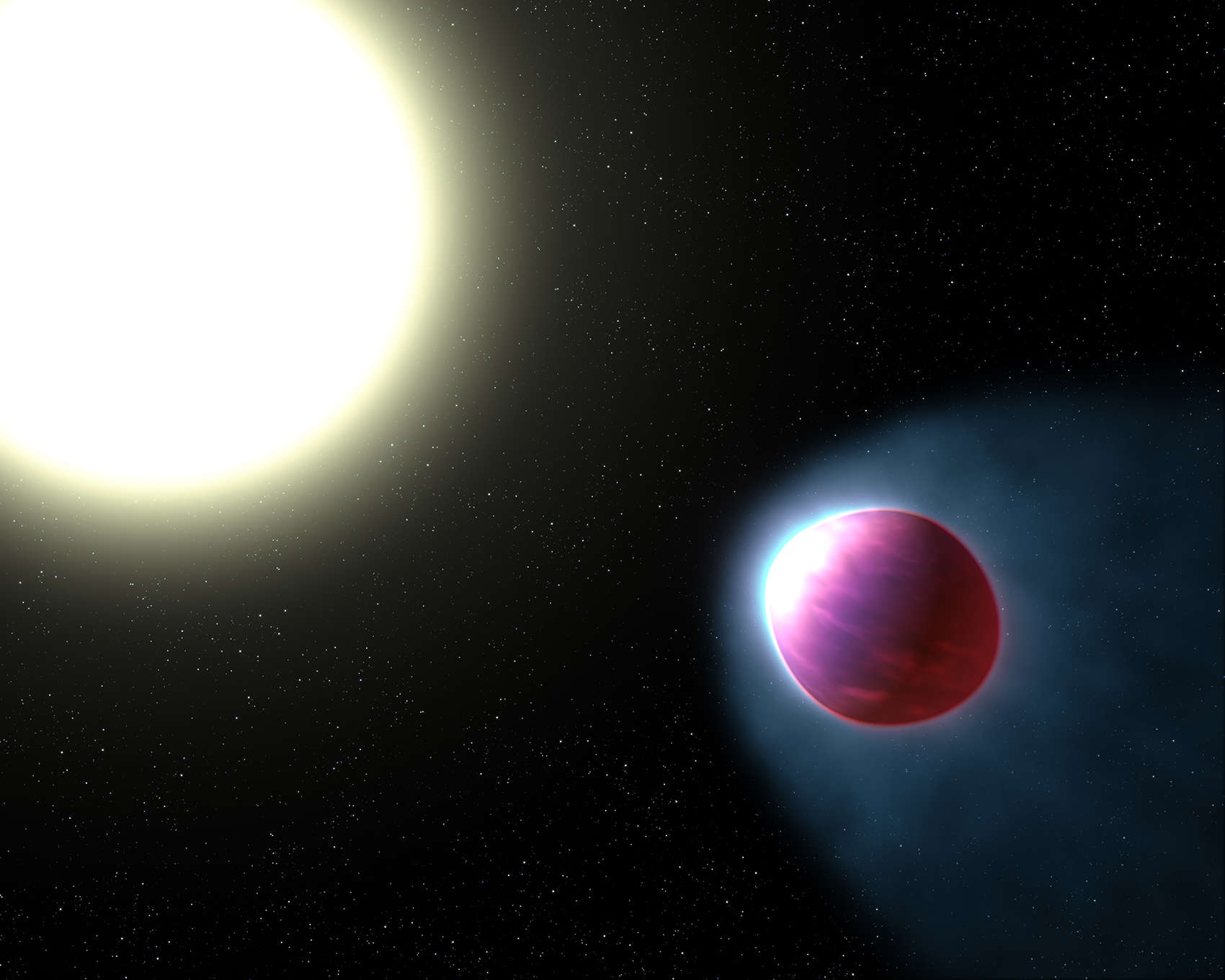Create a free profile to get unlimited access to exclusive videos, sweepstakes, and more!
Heavy metal planet brings the heat

With over 4,200 exoplanets now found — alien worlds orbiting other stars — we're bound to see some that are extreme.
But there's extreme, and there's extreme. WASP-121b is the latter. Hard core. Heavy metal, even.
WASP-121 is a star about 880 light years from the Sun. It's what we call an F6 star, meaning it's more massive, hotter, and brighter than the Sun; about four times brighter.
A planet orbiting the star was discovered in 2015 by the Wide-Angle Search for Planets, or WASP, a series of cameras with telephoto lenses that cover a huge swath of sky looking for transits: when a planet orbiting its star passes directly in front of it, dimming the star's light by a fraction.
WASP-121b, as the planet is called, is just terrifying. It's a little bit more massive than Jupiter (1.2 times) but is much larger, 1.9 times the diameter. That's because it's puffed up. And just why is it puffed up?
Because it's hot. It orbits the star at a distance of less than 4 million kilometers — compare that to Earth's orbit around the Sun of 150 million km. WASP-121b is so close it screams around the star in only 1.27 days, which is just 30.5 hours! Its year is barely more than an Earth day long.
It's so close to the star that it sizzles; the average temperature is about 2100°C (3800°F). And that's the average. The hottest spot on its day side cooks at over 3000°C (5400°F). That's hotter than some stars!
At that temperature chemistry is... interesting. Most molecules get blasted apart from the heat, so there's no water, no oxygen like on Earth. The atmosphere is dominated by hydrogen, and even that is atomic hydrogen; molecular hydrogen (H2) like we see it at Earth-like temperatures can't exist. Even weirder, free electrons (liberated from other atoms like sodium and potassium) combine with the hydrogen atoms to form H-, a species we don't really see on Earth. This atom is really good at absorbing light, so it heats up efficiently and is another reason the atmosphere is so puffy.
Planets like these are called ultra-hot Jupiters, and it's expected their atmospheric behavior is dominated by this hydrogen ion. However, observations of WASP-121b showed it has other chemicals in its air, so a team of astronomers followed up by getting extremely high-resolution spectra of the atmosphere.
What they found is pretty cool (or hot?): magnesium, sodium, calcium, chromium, iron, nickel, and vanadium — what astronomers refer to as metals. That last one is a little funny. Vanadium is not a hugely common element, but when heated to the right temperature it gets very good at absorbing light, making it easy to spot in spectra.
When I studied brown dwarfs for a time — objects more massive than planets but less so than stars, and typically the ones we find are pretty hot — I was surprised to learn that vanadium is commonly seen in their atmosphere for this reason, as is titanium. They tend to appear together, in fact, but in WASP-121b only vanadium is seen. That in itself is weird. But titanium can form molecules even at high temperatures, and at WASP-121b's temperature these molecules actually condense out of the atmosphere... literally raining out! Vanadium is a gas at these temperatures, so it's still seen in the upper atmosphere.
The conclusion to be made here is that planetary atmospheres aren't as simple as we might think, even when conditions (like being blow torched by their star) should make them so.
I know this all sounds strange, but in a way that's the point. Planets like WASP-121b are pretty common, and they are very very different than Earth. Heck, they're different than Jupiter, and they have way more in common with our neighborhood gas giant than they do with us.
There's one more thing I want to point out. When the planet passes in front of its star, some of the starlight passes through the planet's atmosphere. Different elements absorb different wavelengths (colors) of light, so a spectrum can reveal their presence. This is called a transmission spectrum.
But the planet is so hot that it actually glows itself, like a star does! When it's on the other side of its orbit, behind the star so we can't see it, the overall brightness of the system drops some as well (though not nearly as much as when the planet blocks some of the star). A spectrum taken then shows just the star. If you compare that to a spectrum taken when the planet is on our side of the star, you can figure out what elements in its atmosphere are glowing. This is called an emission spectrum.
This tells us about things going on in the atmosphere, including wind speeds; as the wind blows the air color shifts a little bit due to the Doppler shift. They measured wind speeds in the atmosphere of WASP-121b of more than 30 kilometers per second — enough to escape the planet! So the air there is so hot that it literally blows away from the planet… to the tune of 1000 tons per second! That's a lot, though small compared to the total mass of atmosphere; it would take trillions of years to deplete the planet's supply of air.
There's more than pure scientific interest to all of this (besides the usual holy wow-inducing amazement of it). The tools used to examine this incredibly alien world can also be used in some ways to learn more about Earth-like planets. Those are harder to find (they're smaller and cooler, and have less effect on their host stars, making them more difficult to detect) but finding them we are. Characterizing their atmospheres could be very interesting indeed. It's one way we'll be looking for life on other worlds.
Holy wow!
See?




























